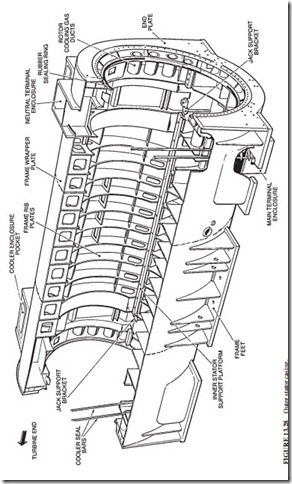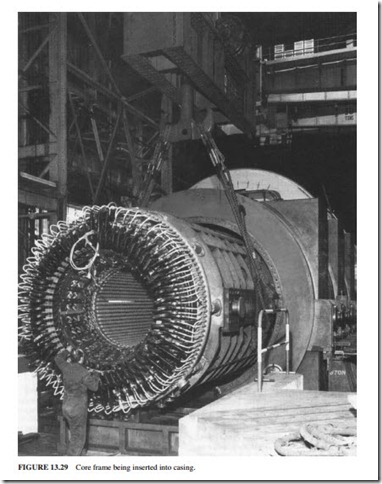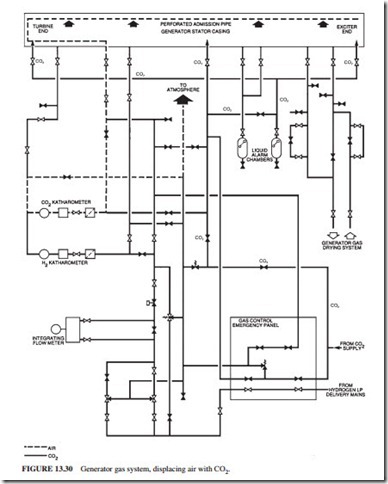COOLING SYSTEMS
The efficiency of a large generator is about 98.5 percent. In some designs, the losses are transferred to the boiler feedwater system.
Hydrogen Cooling
Hydrogen has several advantages over air for heat removal from the generator:
1. The density of hydrogen is one-fourteenth that of air. The windage losses (caused by churning the gas around the rotor) are much less with hydrogen.
2. The heat removal capability of hydrogen (at operating pressure) is about 10 times higher than the one for air.
3. The degradation by oxidation processes cannot occur because hydrogen is free from oxygen.
4. Hydrogen does not support fire, which can start by arcing.
The main disadvantage of hydrogen is that it forms an explosive mixture when it combines with air within a volumetric concentration in the range of 4 to 76 percent. Sophisticated sealing arrangements are required to ensure leak-tight casing.
Hydrogen Cooling Systems
It is essential to prevent air and hydrogen mixture inside the generator. Carbon dioxide is used as a buffer gas between air and hydrogen. The process is called scavenging or gassing up and Downloaded from Digital Engineering Library @ McGraw-Hill (www.digitalengineeringlibrary.com) Copyright © 2004 The McGraw-Hill Companies. All rights reserved.
Any use is subject to the Terms of Use as given at the website.
degassing. Carbon dioxide is normally stored as a liquid. It is expanded to a low pressure above atmospheric. It is also heated to prevent it from freezing due to the expansion process. CO2 is fed into the bottom of the casing through a long perforated pipe. It displaces the air from the top via the hydrogen inlet distribution pipe to atmosphere outside the station. The proportion of CO2 in the gas passing to atmosphere is being monitored by a gas analyzer. When the CO2 concentration becomes sufficiently high, the flow of CO2 is interrupted (Fig. 13.30).
High-purity hydrogen is fed to the casing from a central storage tank or electrolytic process. The hydrogen reaches the gas control panel at about 10 bar. Its pressure is reduced before it flows through the top admission pipe into the casing. Since hydrogen is much lighter than CO2, it displaces the CO2 from the bottom of the casings through the CO2 pipe to atmosphere. The reverse of this procedure is followed to remove hydrogen from the generator for long outages.
Separate procedures are used to scavenge tanks to prevent dangerous mixtures. The reverse of the listed procedure is done using CO2 and dry compressed air to remove hydro- gen from the generator. The hydrogen purity is normally high because air cannot enter a pressurized system.
A sample of casing hydrogen is circulated continuously through a Katharometer-type purity monitor (the sample is driven by the differential pressure developed across the rotor fans). The monitor initiates an alarm if the purity falls below 97 percent. Pure gases from the piped supplies are used to calibrate the purity monitor (and the gas analyzer).
Hydrogen is admitted by a pressure-sensitive valve when the casing pressure drops. A relief valve releases hydrogen to the atmosphere if the pressure becomes excessive. The hydrogen makeup is normally monitored.
Several thermocouples are used to monitor the hydrogen temperature. Hydrogen is flow- ing at 30 m3/s typically (in a 500-MW generator). The heat absorbed by the hydrogen is about 5 MW. The increase in temperature of the hydrogen is about 30°C. The cooled gas should not be at a higher temperature than 40°C. Thus, the hydrogen entering the coolers should not be hotter than 70°C.
The water pressure in the stator windings and hydrogen coolers is lower than the hydro- gen pressure. Therefore, water cannot leak into the hydrogen system from the stator wind- ings or hydrogen cooler. However, water can be released from the oil used for shaft sealing. The water concentration will increase if the oil is untreated turbine lubricating oil which has picked up water from the glands of the steam turbines. The moisture concentration in the hydrogen should be kept low to prevent condensation on the windings. The differential pressure across the rotor fans is used to send a hydrogen flow through a drier. When the rotor is not turning, a motor-driven blower maintains a flow through the rotor (Fig. 13.31).
Hygrometers are used to monitor the humidity of the hydrogen. The maximum permissible dew point is more than 20°C below the cold gas temperature (measured at casing pressure).
In the event of a serious seal failure, hydrogen will escape rapidly. If it encounters an ignition source such as the shaft rubbing, it will burn intensely. In this case, the hydrogen in the casing should be vented to atmosphere. CO2 should be admitted into the casing.


